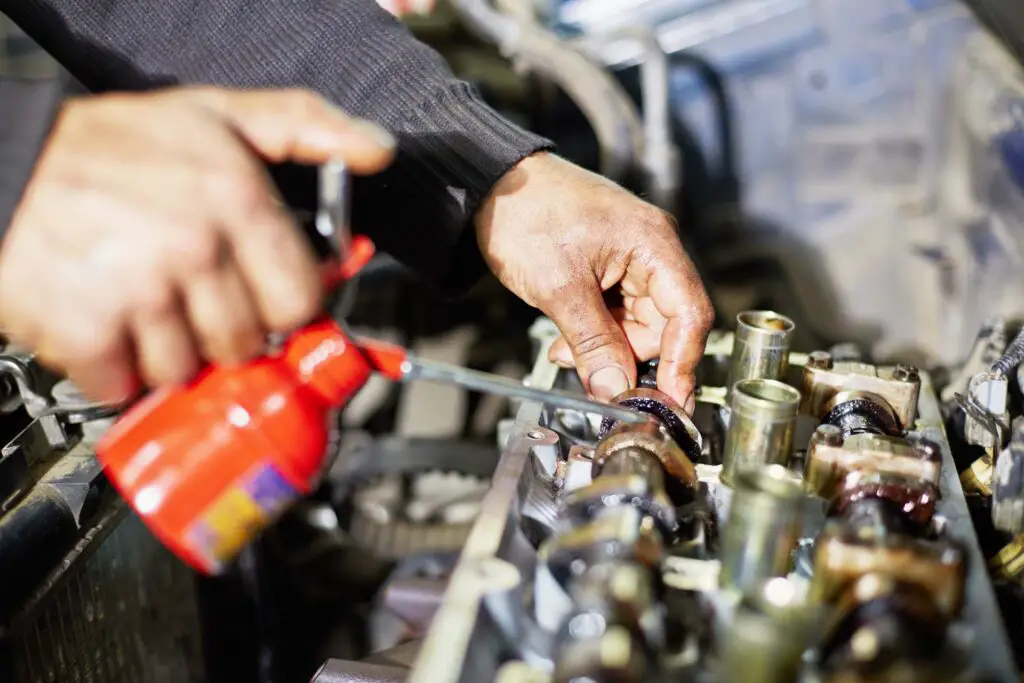Hitting the 30,000-mile mark on your odometer is like reaching a significant milestone in a marathon. Here, both you and your prized ride deserve a pat on the back. But what is done at 30,000-mile service exactly? It’s more than just a routine check – it’s a comprehensive assessment of your four-wheeler and the journey you’ve had so far. From essential replacements to thorough inspections, let’s unfold this crucial milestone car service.
What Is Done at 30,000-Mile Service?
The 30,000-mile mark should follow up with a few key maintenance tasks. This includes changing the engine oil and filter, replacing the cabin air filter, and checking vital vehicle systems, like brakes and transmission. If needed, this visit should include any additional checks or replacements your four-wheeler requires.

Why Is the 30,000-Mile Service One of the Most Important Car Maintenance Milestones?
The 30,000-mile mark stands as a pivotal moment in your vehicle’s life. At this stage, your ride has experienced enough wear and tear to need more than just the basic oil change. Servicing at this time ensures that any minor issues are addressed before they escalate into major problems and expensive repairs.
While the specific services can vary depending on the vehicle’s make and model, they generally cover a comprehensive range of checks and replacements:
- Replacement of the air and cabin filters,
- Oil change and engine fluid check,
- Brake system inspection and maintenance,
- Engine and transmission assessment,
- Suspension and steering check,
- Tire inspection and rotation,
- Car battery performance evaluation,
- Belt and hose inspection.
This Comprehensive Car Check Is Crucial for the Longevity and Performance of Your Prized Ride
This thorough inspection and maintenance routine is not just about the current issues – it’s a proactive approach to car care. Think of it as an investment in your car’s future, safeguarding its performance, reliability, and safety. Regularly hitting this milestone can mean the difference between a car that thrives for years to come and one that struggles with ongoing issues.

Key Components of the 30,000-Mile Vehicle Maintenance Schedule
Alright, let’s dive into the heart of the matter and uncover what exactly lurks under this milestone. Think of it as a spa day for your prized ride. Now, the exact pampering steps can vary depending on the make, model, age, and even where you take it. But, just like there are some classic spa treatments, there are some maintenance tasks that are pretty much the same no matter what:
Engine Health Check
First up, let’s talk about the powerhouse of your four-wheeler – the engine. At 30,000 miles, it’s time to give it a thorough check-up. We’re not just eyeballing here – technicians will meticulously inspect the engine for leaks, wear, and tear. They’ll also check the engine belts and hoses for any signs of aging or damage.
Transmission Inspection
Moving onto the transmission, this inspection is crucial because this component is key to handling the road smoothly. Mechanics will look for leaks, check the transmission fluid’s level and quality, and assess any unusual noises or behaviors.
Brake System Maintenance
Now, let’s hit the brakes – literally. Brake system maintenance is all about safety. The brake pads, rotors, drums, and fluid will be checked and replaced if needed. They’ll also test the brake response and make sure the system is free of air or leaks. This is how you pass the driver’s responsibilities test – you’ve made sure your prized ride is safe and reliable.
Oil Change and Engine Fluids Check
Next up, the oil change and fluids check. This is like a detox for your four-wheeler. Old oil is replaced with fresh, clean oil, and it’s crucial for reducing engine wear and improving efficiency. The mechanic will also check and top up other fluids like coolant, power steering, brake, and transmission fluids.
Air and Fuel Filter Replacement
Last on our list of non-negotiable tasks is replacing the air and fuel filters. This might seem minor, but it’s super important. New filters mean your engine gets clean air and fuel, which is vital for efficient performance and fuel economy. Think of it as helping your car breathe better and burn fuel more effectively.
Driving Habits & Automotive Care Routine – Suspension, Steering, and Tires
Now, let’s shine a light on the unsung heroes of smooth journeys across the famous US routes – the suspension system. It’s like the cushioning that keeps your four-wheeler from feeling like a rollercoaster on bumpy roads.
During this milestone check, the suspension system, including shocks and struts, gets a thorough examination. Mechanics look for signs of wear, leaks, or damage. It’s all about keeping your ride stable and smooth, no matter if you’re on or off the road.
The Steering System Is Just as Important for a Comfortable Drive
Next up, let’s steer toward the steering system. If it’s well-functioning, you’ve got a safe and responsive driving experience. So, the mechanic will check for any looseness, vibrations, or odd noises when you turn the wheel. Here are some things they might look into:
- Power steering fluid level and quality check,
- Inspection of steering gear and linkage,
- Examination of tie rods and ball joints for wear.
Tire Inspection Should Be Done at Every Visit, No Matter the Miles
When it comes to tires, they’re literally where the rubber meets the road. At every service visit, including the 30,000-mile one, your tires should definitely get some love. This includes a tire rotation, which helps them wear evenly and last longer. Plus, an alignment check ensures your vehicle drives straight and doesn’t pull to one side.

Are There Any Additional Inspections and Replacements Done at the 30,000-Mile Auto Check-Up?
While we’ve covered the essential services, it’s important to remember that no two four-wheelers are exactly alike. Depending on your car’s make and model, as well as how you drive it, there might be a few extra things that need attention at this point.
The Car Battery Might Be Due for a Replacement
Speaking of additional checks, let’s not forget the car battery. This little powerhouse typically needs a replacement every 3 to 4 years. If the timing lines up, it might be time to say goodbye to the old one. Keep an eye out for things like:
- Your vehicle struggles to start, or the engine cranks slowly,
- The battery light on your dashboard flickers on,
- You notice any swelling or bloating in the battery case,
- The battery’s age is more than three years,
- Dimming headlights or interior lights.
Belts, Hoses, and Other Components That Might Need Some Work As Well
Lastly, let’s not overlook the belts, hoses, and other critical components under the hood. They might seem small, but they play big roles in your car’s performance. During your check, mechanics will give these parts a thorough inspection. They’ll be looking for cracks, leaks, and wear and tear. With that, we’ve covered most of the tasks this milestone upkeep will usually entail.
DIY vs. Professional Services – Which Is the Right Route for You?
When it comes to the 30,000-mile service, having a professional take the wheel comes with its perks. They have the expertise, the right tools, and the know-how to diagnose and fix issues that might not be obvious to the average car owner.
But, let’s hit the brakes for a second – professional services, while thorough, can also be pricier. This might lead some of you, especially the more mechanically inclined, to consider rolling up your sleeves and diving into some DIY maintenance.
What Can Be Done at Home?
With the right tools and a bit of know-how, there are a few tasks you might be inclined to tackle at home. Here are some of them:
- Oil and filter change,
- Air filter replacement,
- Checking engine oil, coolant, brake fluid, and transmission fluid,
- Tire rotation,
- Basic inspection of belts, hoses, and brakes.

Crossing the Finish Line and Steering Your Ride Into the Future
As we cruise to the end of our 30,000-mile journey, remember that this is not just a simple pit stop – it’s a launchpad for your car’s next adventures. It’s like a love letter to your prized ride, and at this milestone, it’s time to pen a thoughtful one. So, buckle up and drive confidently into the future, knowing you’ve set the stage for many more miles of happy, safe, and smooth driving.
Frequently Asked Questions
How Often Should the 30,000-Mile Service Be Performed?
The 30,000-mile service should be performed once your vehicle reaches this distance, repeating every time this milestone is reached. It’s a standard maintenance interval for many vehicles, aligning with their manufacturer’s recommended schedule.
How Much Does a Typical 30,000-Mile Service Cost?
The cost of this crucial servicing can vary widely, typically ranging from $200 to $500, depending on the vehicle make and model, the type of work needed, and the region where it’s performed. Luxury vehicles or those requiring specialized parts or fluids may result in higher costs.
What Are the Potential Risks of Skipping the 30,000-Mile Service?
Skipping this crucial servicing can lead to increased wear and tear on the machine, resulting in costly repairs. It can also lead to decreased performance, reduced fuel efficiency, and possibly voiding the vehicle’s warranty.
Can I Perform My 30,000-Mile Service at Home?
Performing this maintenance task at home is possible if you have the necessary skills, tools, and knowledge. However, it typically involves various checks and replacements, such as oil change, air filter replacement, and fluid checks, which might require expertise and specific tools.
Are There Any Specific Checks for Hybrid or Electric Vehicles at 30,000 Miles?
Hybrid and electric vehicles may have specific checks at this milestone, such as battery health assessments, inspection of electric motor components, and software updates. These checks are in addition to the standard maintenance tasks performed on all vehicles.








